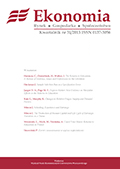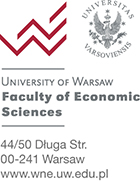W. Grabowski, K. Rotuski, K. Skrzypczak
ABSTRACT:
Full text (PDF)
Issue number: 27
In this issue:
Spory o naturę ekonomii dobrobytu we współczesnej metodologii ekonomii
B. Czarny
ABSTRACT |
PDF
In this article I describe dispute about whether welfare economics is normative economics, or the positive economics. The introduction to the discussion was a debate between Ezra Mishan and Pieter Hennipman in 1982–1984. It resulted in Mishan’s acceptation of the Hennipman’s view, that welfare economics is a part of the positive economics. After a couple of years the topic appeared back in the economic journals. In the first part of this article I present views of George Archibald, Pieter Hennipman and Yew-Kwang Ng,which treat welfare economics as a part of positive economics. In the second part I present contrary opinions of Mark Blaug. In the third part I present counterarguments, which (in my opinion) undermine Blaug’s position. I end with the hypothesis that dispute, which I described, can be caused—among others—by the existing, since the time of John Neville Keynes and Max Weber, ambiguity of the terms "positive economics" and "normative economics".
Biedni pracujący w XXI wieku
E. Polak
ABSTRACT |
PDF
One of the recently observed trends in Poland, as in most other countries, is the increase in the distances between the different income segments of the labor market. This is accompanied by an increase in relative poverty of the employees. In the nineties in the twentieth century the term of working poor appeared. In discussions on poverty, however, many problems are mainly ignored such as: poor workers, fair pay, access to market offers, quality housing, effective health care, modern education and the judiciary. Poverty is mainly associated with unemployment, homelessness and social exclusion. The problem of low salaries is considered a natural consequence ofmarket competition and the skills and labor market activity of individual units. The process of increasing economic stratification is not an autonomous phenomenon, arising only from the different attitudes, life strategies, skills, abilities and determination of individual units, but increasingly it is the consequence of economic liberalization and globalization effect distribution. The existence of poor working reduces the number of unemployed and improves the economic situation of the companies, but generates new problems such as: a growing number of inactive people, unstable employment situation and income, the growing movement of employees, lack of job security, economic and non-economic deprivation of employment, social discontent, social disintegration and hidden unemployment.
Rynek płatności bezgotówkowych w Polsce na tle Unii Europejskiej — analiza komparatywna
E. Ślązak
ABSTRACT |
PDF
The main aim of the paper is the comparative analysis of Polish cashless payments on the background of European Union payment statistics. The primary finding involves the scale of gap between Poland and EU in terms of direct credit and direct debit instruments. Despite the overwhelming popularity of direct credit on the domestic market, its usage especially among individuals is still very moderate situating Poland at the bottom of 27 EU countries. On the other hand, direct credit payments play a sole role in non-cash payments ordered on the basis of bank accounts as the importance of direct debit is extremely limited. As far as card payments are concerned, it should be emphasized the dynamic growth of volume issued cards as well as the value of transactions. However, contrary to developed EU card markets, the leading role of debit card in Poland signals still initial state of long-term development trends in domestic market. Furthermore, the fast growing importance of credit cards Poland has been halted towards the end of 2010 under the pressure of growing credit risk exposure in form of increasing ratio of non-performing credits extended within credit card.
Audyt jako narzędzie detekcji niekorzystnego wpływu instrumentów pochodnych na przedsiębiorstwo
P. Kowalski
ABSTRACT |
PDF
High-amplitude of changes in foreign exchange markets had often a negative impact on the financial results of Polish exporters in 2008—2009. The design of adopted financial instruments and the height of the security show insufficient internal control over the implementation of the exchange rate risk protection policy in public entities, where financial loss has repeatedly exceeded the expected benefits. Most of the serious irregularities in this aspect came out of speculative transactions of senior or middle management staff and errors caused by faulty estimates, or insufficient knowledge about the design of derivatives. The text refers to the above situation, resulting from the need to thoroughly verify the current level of risk by the amount of securities derivatives in the company. The author’s is to remind the regulations which would significantly reduce risk and demonstrate a mechanism whereby members of the internal audit committee under the board and external auditors, and the government of the company to protect the examined subject from the risk from improper use of the potential which undoubtedly are given by currency options. Support for active security policy is the indicator presented in Chapter 2. Extremely important is the fact that the meter will indicate the risk ex ante, before the consequences in the form of financial losses and an increase in long-and short-term debt.
Banki centralne jako wiodące instytucje publiczne w dążeniu do poprawy efektywnooeci funkcjonowania — część II
L. Chodorowski
ABSTRACT |
PDF
This article consists of 2 parts and describes the importance of improving the effectiveness and efficiency of central banks’ performance. Firstly, central banks are seen as important representatives of public institutions, and their effectiveness and efficiency are shown on the grounds of microeconomics. Secondly, the kinds of organizational structures, which are typical for central banks or which are possible to be used, are analyzed due to the effectiveness and efficiency. In the second part of the article the author, drawing on the experience of central banks, provides an overview of the following types of organizational structures: hierarchic, indirect, organic and the structure based on process maps (the hierarchic structure is the most popular for central banks at present). These structures have been shortly described and assessed. It seems that the structure based on the process approach may be the most effective and efficient. Therefore, the author also presents a strategy and methods of transformation from the hierarchic structure (or similar) to the structure based on the process approach.
Istota kapitału i wartości marki
I. Wasilewska
ABSTRACT |
PDF
This article is the introduction to the research project on a set of 130 companies exploring how the brand equity contributes to gain and maintain competitive advantage and business value creation. The study groupwill cover 130 domestic companies listed on the WSE in the period of 2002–2006. During this period the Polish companies in a favorable macroeconomic environment. The question is whether they were able to take advantage of favorable economic conditions to generate/increase the value of the company and which ones and how they used the brand equity of the company’s value creation. Competing consists of a lot of Darwinism. In the maze of perception and subjective value judgments, subject of the transaction role of the brand is essential and what is more, you can hypothesize that it is generic, independent of time and the market sector in which the firm operates. The brand has the ability to generate future income: differentiates, reduces risk and complexity, compensates for pressure on prices and offering added value, reduces pricing flexibility. Mark provides the increase in sales and provides improvement of operating cash flows. With these abilities it can be regarded as a determinant of corporate value and it can be regarded as one of the strategic business activity giving rise to its value. Reflections on the essence of the brand equity and its value begins with an explanation of the subjective nature of the value. Than the article describes the role of the brand in creating the value. Detailed concepts of Kampfer and Upshaw brand and the concept of brand equity by David Aaker explain the source of its value. It is the case of the so-called brand equity, defining it as a set of assets and liabilities associated with the brand, and brand value, a valuation of brand equity. The base of the brand equity is the prospect of making a profit in subsequent periods as a result of investments in individual assets and make the appropriate actions in earlier periods. The article presents the various techniques for estimating the value of brand equity. It should be noted that among the many methods of estimating the value of brand equity the most appropriatemethod seems to be taking into account the impact of the brand to generate future cash flows. In this regard, the DCF methods should be mentioned, and especially economic gains market value (taking into account the theoretical model of brand valuation to the market value by C.J. Simon and M.W. Sullivan, 1993).
Znaczenie systemu ochrony praw własności intelektualnej w realiach gospodarki opartej na wiedzy
A. Balcerzak, E. Rogalska
ABSTRACT |
PDF
The article discuses the increasing significance of protecting intellectual property rights in the knowledge based economy. The most common approach to this problemwhich can be seen in the public debate stresses the role of technological competition between market players and says that reforms of intellectual property protection system should facilitate process of obtaining patent protection for bigger amount of innovations of all kinds for longer time. This should encourage all companies to invest in research and development, which will improve innovation capability of the whole economy. The article shows that realization of this common belief can lead to some counterproductive results, which can especially be important in case of knowledge based economy sectors. On the other hand, the article argues that the discussion on intellectual property protection should not only concentrate on the technological competition process, but it should also take into consideration an influence of the reform on the technological cooperation process. This is especially important in case of creating an institutional background for cooperation between so called general purpose technology sectors and application technology sectors, which can be the core of innovation process in the knowledge based economy.
Zastosowanie wieloobiektowej aukcji pierwszej ceny w systemie rejestracji studentów USOS
T. Kopczewski, P. Ziewiec
ABSTRACT |
PDF
The article shows a possibility of applying the multi-object first-price auction to the students registration system for the class at the University Study-Oriented System (called USOS). On the basis of experimental data and the Monte Carlo simulation changes in the effectiveness were determined after the possible introduction of the new type of registration based on the auction system in relation to existing systems of registration and it was determined whether this system will motivate the students.

